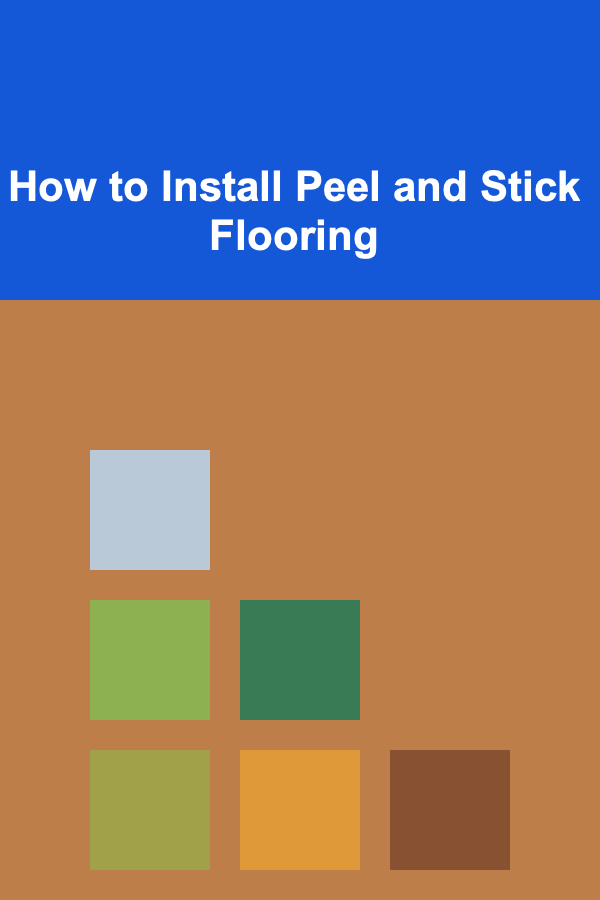
How to Install Peel and Stick Flooring
ebook include PDF & Audio bundle (Micro Guide)
$12.99$9.99
Limited Time Offer! Order within the next:

Peel and stick flooring has become a popular choice for homeowners and DIY enthusiasts due to its convenience, cost-effectiveness, and ease of installation. Whether you're renovating a single room or updating an entire home, peel and stick flooring offers a straightforward solution for adding a fresh look to your floors. This type of flooring eliminates the need for complicated tools or professional assistance, allowing you to complete the project yourself.
In this guide, we will walk you through the step-by-step process of installing peel and stick flooring, from preparing the area to applying the tiles or planks. By following these instructions, you'll be able to transform your space efficiently and with minimal effort.
Why Choose Peel and Stick Flooring?
Before we dive into the installation process, let's first discuss why peel and stick flooring is an attractive option for many homeowners:
- Ease of Installation: The most significant advantage of peel and stick flooring is its ease of installation. No glue or special equipment is needed -- simply peel off the backing and press the tiles into place. The adhesive is already on the back, making it simple to install even for beginners.
- Cost-Effective: Compared to traditional flooring options, such as hardwood or tile, peel and stick flooring is typically much more affordable. This makes it an ideal choice for budget-conscious homeowners looking for a quick and low-cost upgrade.
- Variety of Designs: Peel and stick flooring comes in a wide range of colors, patterns, and textures, allowing you to find a style that complements your home decor. From faux wood and stone finishes to contemporary designs, there's a peel and stick floor to suit every taste.
- Durability and Maintenance: Although peel and stick flooring is generally not as durable as hardwood or ceramic tile, it can still withstand daily wear and tear. The flooring is also easy to maintain, requiring only regular sweeping and occasional mopping.
- Temporary or Permanent: Peel and stick flooring can be a temporary solution for renters or homeowners who want to upgrade their floors without making permanent changes. If you decide to move or renovate in the future, removing the tiles is relatively simple.
Now that we've highlighted the advantages, let's look at how to install peel and stick flooring yourself.
Materials and Tools You Will Need
To install peel and stick flooring, you'll need a few basic materials and tools. Most of these items are easy to find at your local hardware store or online:
Materials:
- Peel and stick tiles or planks (choose the style and size that best fits your space)
- Floor cleaner (mild detergent or floor cleaner)
- Adhesive strips (optional for extra security)
- Floor roller (optional for pressing tiles down)
Tools:
- Tape measure
- Utility knife or scissors
- Carpenter's square
- Level
- Pencil or chalk for marking
- Ruler or straight edge
- Bucket with water for cleaning
- Damp mop or cloth for cleaning the floor
Step-by-Step Guide to Installing Peel and Stick Flooring
Step 1: Prepare the Area
Before you begin, it's essential to prepare the floor properly. A clean and smooth surface is crucial for ensuring the tiles adhere well.
- Clear the Area: Remove all furniture, rugs, and other items from the room. This will give you ample space to work and prevent any damage to your belongings.
- Clean the Floor: Sweep or vacuum the floor to remove dust and debris. If the floor is especially dirty, mop it with a mild detergent to ensure it's completely clean. Make sure the floor is dry before proceeding.
- Inspect the Surface: Check the floor for any cracks, bumps, or imperfections. If you find any damage, repair it with a filler or patching compound. It's essential that the surface is as smooth as possible to ensure proper adhesion.
- Level the Floor: If the floor is uneven, use a leveling compound to smooth out any low spots. This is especially important in high-traffic areas, as uneven floors can cause the tiles to peel up over time.
Step 2: Plan the Layout
Planning the layout of your peel and stick flooring is a critical step to ensure a professional-looking finish. Here's how to proceed:
- Measure the Room: Using your tape measure, take accurate measurements of the room to determine how many tiles or planks you will need. It's always a good idea to buy extra flooring in case of mistakes or future repairs.
- Find the Center: To create a balanced look, find the center of the room and mark it with a pencil. You can use a carpenter's square to draw straight lines that intersect at the center of the room. This will act as your reference point for the installation.
- Dry Lay the Tiles: Before peeling off the backing, lay the tiles out on the floor without removing the adhesive backing. This will help you visualize how the tiles will fit and allow you to make adjustments if necessary. Try to align the tiles with the center line to ensure they are evenly spaced.
Step 3: Start Installing the Tiles
Once you've planned the layout, it's time to begin the actual installation:
- Peel the Backing Off: Starting at your reference point, peel the backing off the first tile. Be careful not to touch the adhesive side of the tile with your fingers, as this can reduce its stickiness.
- Place the Tile: Carefully align the tile with your center line or starting point. Press it firmly into place, starting from the center and working your way out to the edges. If the tiles are large, it may help to use a floor roller or your hands to ensure full adhesion.
- Continue Installing Tiles: Continue placing tiles row by row, working your way toward the edges of the room. If you encounter any gaps or need to cut tiles to fit, use a utility knife or scissors to make precise cuts.
- Check for Alignment: As you work, periodically check that the tiles are aligned and level. Use a carpenter's square to make sure the lines are straight and the tiles are evenly spaced. Adjust as necessary before pressing down firmly.
Step 4: Cutting Tiles to Fit
When you reach the edges of the room, you'll need to cut some tiles to fit. Here's how to do it properly:
- Measure the Space: Measure the gap between the edge of the tile and the wall. Add a small allowance to ensure the tile fits snugly.
- Cut the Tile: Use a utility knife or scissors to carefully cut the tile to the desired size. You can use a straight edge or carpenter's square to guide your cuts and ensure a clean line.
- Fit the Tile: Place the cut tile in the gap and press it firmly into place. Make sure the cut edge is flush with the wall or baseboard.
Step 5: Roll and Press the Tiles
After all the tiles are in place, use a floor roller or your hands to press them down firmly. This helps to eliminate any air bubbles and ensures a secure bond between the tile and the floor.
Step 6: Final Touches
Once the tiles are installed and pressed down, do a final inspection to ensure everything is aligned and well-secured. If necessary, use a damp cloth to wipe off any excess adhesive or dust.
- Allow to Set: Give the floor at least 24 hours to settle before moving furniture back into the room. This allows the adhesive to fully bond with the surface.
- Install Baseboards: If you removed baseboards earlier, now is the time to reinstall them to cover any gaps between the flooring and the wall.
Tips for a Successful Installation
- Start in a Corner: If possible, start in the farthest corner of the room and work your way toward the exit. This prevents you from stepping on the newly installed tiles and disrupting their placement.
- Use a Level: Even a slight tilt in your flooring can cause problems, so use a level to ensure that your tiles are perfectly flat.
- Work Slowly: Don't rush the installation process. Take your time to ensure that each tile is aligned correctly and adheres properly.
- Cut Carefully: When cutting tiles to fit, take your time and make sure you're measuring and cutting accurately. Mistakes can be difficult to fix once the tiles are in place.
Conclusion
Installing peel and stick flooring is an easy and cost-effective way to update the look of any room in your home. With the right preparation, careful planning, and attention to detail, you can achieve professional-looking results without the need for expensive contractors or complicated tools.
By following the steps outlined in this guide, you'll be able to transform your floors into a stylish and durable surface that enhances the overall look of your home. Whether you're looking to refresh a single room or complete an entire house, peel and stick flooring offers a simple and satisfying solution.
Reading More From Our Other Websites
- [Organization Tip 101] How to Organize Your Dining Room for Family Gatherings
- [Personal Investment 101] How to Invest in Bonds for Steady Returns and Lower Risk
- [Organization Tip 101] Why A Tidy Entryway Sets a Positive Tone for the Day
- [Personal Investment 101] Turning Deep Learning Into a Passive Income Business
- [Stamp Making Tip 101] Creative Stamp Designs: Inspiring Ideas to Elevate Your Craft
- [Organization Tip 101] How to Create a Scrapbook or Journal for Your Collection
- [Star Gazing Tip 101] From Sky to Smartphone: Using Apps to Identify Stars and Constellations
- [Personal Care Tips 101] How to Choose the Best Deodorant for Hyperhidrosis (Excessive Sweating)
- [Personal Investment 101] How to Use Deep Learning for Predictive Analytics to Make Money
- [Home Party Planning 101] How to Host a Tropical Luau Party in Your Living Room

How to Make Your Home More Secure with Smart Home Technology
Read More
How to Manage Seasonal Clothing with Ease
Read More
How to Start a Family Fitness Challenge at Home
Read More
How to Use Smart Locks for Enhanced Home Security
Read More
How to Teach Your Child Financial Responsibility: A To-Do List
Read More
10 Tips for Managing Home To-Do Lists with a Partner
Read MoreOther Products

How to Make Your Home More Secure with Smart Home Technology
Read More
How to Manage Seasonal Clothing with Ease
Read More
How to Start a Family Fitness Challenge at Home
Read More
How to Use Smart Locks for Enhanced Home Security
Read More
How to Teach Your Child Financial Responsibility: A To-Do List
Read More